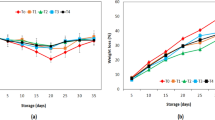Abstract
Here, we examine the chemical quality (total protein, total lipid, starch, piperine, and essential oil) and flavor quality of white pepper (Piper nigrum L.) derived from five new genotypes (Jianyin-1, Banyin-1, Banyin-2, Banyin-3, and Banyin-4). We employed headspace solid-phase micro-extraction gas chromatography mass spectrometry (HS-SPME-GC-MS) to analyze major volatiles, electronic nose (E-nose) to analyze volatiles of unknown nature, and sensory testing to assess flavor quality of white pepper derived from these five genotypes. The piperine and essential oil values were significantly higher in Jianyin-1 than in any of the other samples, and this was in accordance with the sensory evaluation results, which indicated that this sample also possesses the most intense pungency notes of all of the samples. The characterization of the chemical quality, volatile compounds, and volatile profiles of all five pepper cultivars showed a clear difference between Jianyin-1 and all of the other samples, perhaps indicative of its unique hybrid origin for the four latter genotypes. The E-nose pattern matching used to examine the volatiles of unknown nature of white pepper derived from all five genotypes further supported our sensory and instrumental data and suggested that Jianyin-1 is a promising and pungent pepper cultivar useful for cultivation for human consumption.

Similar content being viewed by others
References
Ramakrishnan Nair R, Dutta Gupta S (2003) Somatic embryogenesis and plant regeneration in black pepper (Piper nigrum L.): I. Direct somatic embryogenesis from tissues of germinating seeds and ontogeny of somatic embryos. J Hortic Sci Biotechnol 78(3):416–421
Ahmad N, Fazal H, Abbasi BH, Rashid M, Mahmood T, Fatima N (2010) Efficient regeneration and antioxidant potential in regenerated tissues of Piper nigrum L. Plant Cell Tissue Organ Cult 102(1):129–134
Abbasi BH, Ahmad N, Fazal H, Mahmood T (2010) Conventional and modern propagation techniques in Piper nigrum. J Med Plant Res 4:007–012
Khan S, Mirza KJ, Anwar F, Abdin MZ (2010) Development of RAPD markers for authentication of Piper nigrum L. Environ We Int J Sci Technol 5:553–562
Jiang Y, Liu J (2011) Analysis of genetic diversity of Piper spp. in Hainan Island (China) using inter-simple sequence repeat ISSR markers. Afr J Biotechnol 10(66):14731–14737
Zheng W (1999) Germplasm resources of wild pepper and their use. Guangxi Sci Technol Trop Crops 73:12–13
Ravindran P (2000) Black Pepper, Piper Nigram: Piper nigrum, vol 13. CRC
Peter K (2004) Handbook of herbs and spices, vol 2. CRC
Steinhaus M, Schieberle P (2005) Characterization of odorants causing an atypical aroma in white pepper powder (Piper nigrum L.) based on quantitative measurements and orthonasal breakthrough thresholds. J Agric Food Chem 53(15):6049–6055
Nitz S (1996) Quality and stability of high-pressure extracts from spices (in German). Paper presented at the Forschungskreis der Erna¨hrungsindustrie, Bonn, Germany
Jagella T, Grosch W (1999) Flavour and off-flavour compounds of black and white pepper (Piper nigrum L.) III. Desirable and undesirable odorants of white pepper. Eur Food Res Technol 209(1):27–31
Jagella T, Grosch W (1999) Flavour and off-flavour compounds of black and white pepper (Piper nigrum L.) I. Evaluation of potent odorants of black pepper by dilution and concentration techniques. Eur Food Res Technol 209(1):16–21
Jagella T, Grosch W (1999) Flavour and off-flavour compounds of black and white pepper (Piper nigrum L.) II. Odour activity values of desirable and undesirable odorants of black pepper. Eur Food Res Technol 209(1):22–26
Mazida MM, Salleh MM, Osman H (2005) Analysis of volatile aroma compounds of fresh chilli (Capsicum annuum) during stages of maturity using solid phase micro extraction (SPME). J Food Compos Anal 18(5):427–437
Guillot S, Peytavi L, Bureau S, Boulanger R, Lepoutre JP, Crouzet J, Schorr-Galindo S (2006) Aroma characterization of various apricot varieties using headspace–solid phase micro extraction combined with gas chromatography–mass spectrometry and gas chromatography–olfactometry. Food Chem 96(1):147–155
Frank DC, Owen CM, Patterson J (2004) Solid phase microextraction (SPME) combined with gas-chromatography and olfactometry-mass spectrometry for characterization of cheese aroma compounds. LWT Food Sci Technol 37(2):139–154
Jirovetz L, Buchbauer G, Ngassoum MB, Geissler M (2002) Aroma compound analysis of Piper nigrum and Piper guineense essential oils from Cameroon using solid-phase microextraction–gas chromatography, solid-phase microextraction–gas chromatography–mass spectrometry and olfactometry. J Chromatogr A 976:265–275
Wood A, Barrow ML, James D (1988) Piperine determination in pepper (Piper nigrum L.) and its oleoresins—a reversed-phase high-performance liquid chromatographic method. Flavour Fragr J 3(2):55–64
Orav A, Stulova I, Kaila T, Muuisepp M (2004) Effect of storage on the essential oil composition of Piper nigrum L. fruits of different ripening states. J Agric Food Chem 52:2582–2586
Cardeal ZL, Gomes da Silva MD, Marriott PJ (2006) Comprehensive two-dimensional gas chromatography-mass spectrometric analysis of pepper volatiles. Rapid Commun Mass Spectrom 20(19):2823–2836
Parthasarathy VA, Chempakam B, Zachariah TJ (2008) Chemistry of spices. CABI
Rizzolo A, Polesello A, Polesello S (1992) Use of headspace capillary GC to study the development of volatile compounds in fresh fruit. J High Resolut Chromatogr 15(7):472–477
Mamatha B, Prakash M, Nagarajan S, Bhat K (2008) Evaluation of the flavor quality of pepper (Piper nigrum L.) cultivars by GC-MS, electronic nose and sensory analysis techniques. J Sens Stud 23(4):498–513
Narasimhan S, Chand N, Rajalakshmi D, Indiramma A (1990) Quality of powdered black pepper(Piper nigrum L.) during storage I. Sensory and physicochemical analyses. J Sens Stud 4(4):229–240
Narasimhan S, Rajalakshmi D, Chand N (2007) Quality of powdered black pepper (Piper nigrum L.) during storage II. Principal components analyses of GC and sensory profiles. J Food Qual 15(1):67–83
Acknowledgments
This study was funded by The National Key Technology Research and Development Program of China (2012BAD36B03).
Conflict of interest
None.
Compliance with Ethics Requirements
This article does not contain any studies with human or animal subjects.
Author information
Authors and Affiliations
Corresponding author
Rights and permissions
About this article
Cite this article
Liu, H., Zeng, F.K., Wang, Q.H. et al. Studies on the chemical and flavor qualities of white pepper (Piper nigrum L.) derived from five new genotypes. Eur Food Res Technol 237, 245–251 (2013). https://doi.org/10.1007/s00217-013-1986-x
Received:
Revised:
Accepted:
Published:
Issue Date:
DOI: https://doi.org/10.1007/s00217-013-1986-x




